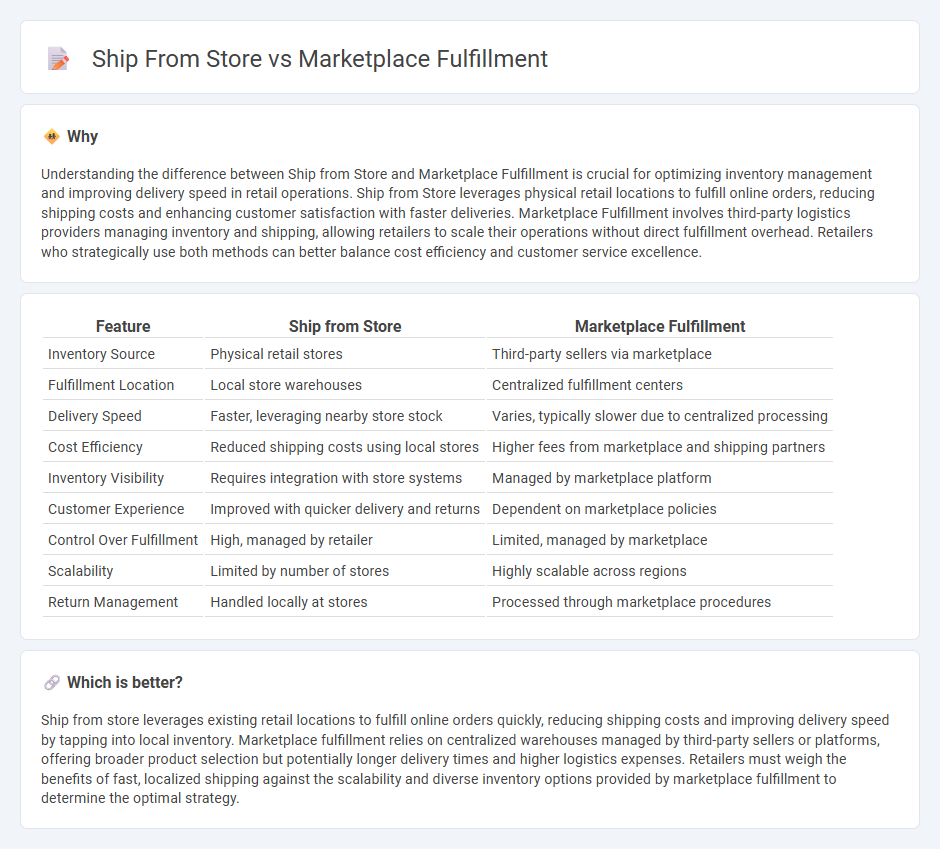
Ship from store leverages physical retail locations to fulfill online orders quickly, reducing shipping times and costs by utilizing nearby inventory. Marketplace fulfillment involves third-party sellers storing and shipping products through centralized warehouses, expanding product availability and reach. Explore the benefits and challenges of each method to determine the best strategy for your retail business.
Why it is important
Understanding the difference between Ship from Store and Marketplace Fulfillment is crucial for optimizing inventory management and improving delivery speed in retail operations. Ship from Store leverages physical retail locations to fulfill online orders, reducing shipping costs and enhancing customer satisfaction with faster deliveries. Marketplace Fulfillment involves third-party logistics providers managing inventory and shipping, allowing retailers to scale their operations without direct fulfillment overhead. Retailers who strategically use both methods can better balance cost efficiency and customer service excellence.
Comparison Table
| Feature | Ship from Store | Marketplace Fulfillment |
|---|---|---|
| Inventory Source | Physical retail stores | Third-party sellers via marketplace |
| Fulfillment Location | Local store warehouses | Centralized fulfillment centers |
| Delivery Speed | Faster, leveraging nearby store stock | Varies, typically slower due to centralized processing |
| Cost Efficiency | Reduced shipping costs using local stores | Higher fees from marketplace and shipping partners |
| Inventory Visibility | Requires integration with store systems | Managed by marketplace platform |
| Customer Experience | Improved with quicker delivery and returns | Dependent on marketplace policies |
| Control Over Fulfillment | High, managed by retailer | Limited, managed by marketplace |
| Scalability | Limited by number of stores | Highly scalable across regions |
| Return Management | Handled locally at stores | Processed through marketplace procedures |
Which is better?
Ship from store leverages existing retail locations to fulfill online orders quickly, reducing shipping costs and improving delivery speed by tapping into local inventory. Marketplace fulfillment relies on centralized warehouses managed by third-party sellers or platforms, offering broader product selection but potentially longer delivery times and higher logistics expenses. Retailers must weigh the benefits of fast, localized shipping against the scalability and diverse inventory options provided by marketplace fulfillment to determine the optimal strategy.
Connection
Ship from store and marketplace fulfillment are integrated strategies enhancing retail distribution by leveraging physical stores as local fulfillment centers to expedite order delivery. This connection allows retailers to optimize inventory utilization across multiple sales channels, reducing shipping costs and improving delivery speed within marketplace platforms. Utilizing in-store inventory for marketplace orders increases order fulfillment efficiency and elevates customer satisfaction through faster, more flexible shipping options.
Key Terms
Inventory management
Marketplace fulfillment centralizes inventory in warehouses, allowing streamlined stock tracking and faster order processing, reducing the risk of overselling. Ship from store leverages physical retail locations as fulfillment centers, enhancing inventory turnover and improving customer delivery speed by utilizing local stock. Explore in-depth strategies to optimize inventory management for both fulfillment models.
Order routing
Marketplace fulfillment directs customer orders to third-party sellers or fulfillment centers based on inventory availability, shipping speed, and cost efficiency, optimizing order routing by leveraging distributed networks. Ship from store fulfillment routes orders to the nearest physical retail location with stock, reducing delivery times and last-mile expenses while enhancing customer experience through local inventory utilization. Discover how advanced order routing strategies elevate operational efficiency by exploring detailed comparisons of marketplace fulfillment and ship from store methods.
Delivery speed
Marketplace fulfillment often leverages centralized warehouses, enabling faster shipping through optimized inventory management and bulk distribution, significantly reducing delivery times for customers. Ship from store utilizes local retail locations to dispatch products, which can expedite deliveries in nearby areas but may face limitations in scale and consistency compared to centralized fulfillment centers. Explore detailed comparisons to understand how delivery speed impacts customer satisfaction in both fulfillment models.
Source and External Links
A Guide To Marketplace Fulfillment - Marketplace fulfillment is the process where products sold on marketplaces like Amazon or Walmart are stored, packed, shipped, and sometimes returned by the marketplace operator or a third party, helping brands reach new customers and streamline order handling.
Leverage Multi-Channel Fulfillment to fulfill your Walmart Marketplace orders - Amazon's Multi-Channel Fulfillment (MCF) offers sellers on marketplaces like Walmart a fast, reliable service that consolidates inventory and automates order fulfillment, including shipping with unbranded boxes and tracking update integration.
Effortless Marketplace Fulfillment Center - Marketplace fulfillment services are third-party solutions managing logistics such as storage, packing, shipping, returns, and sometimes customer service for sellers on marketplaces, helping with efficiency, scalability, and cost savings.
 dowidth.com
dowidth.com